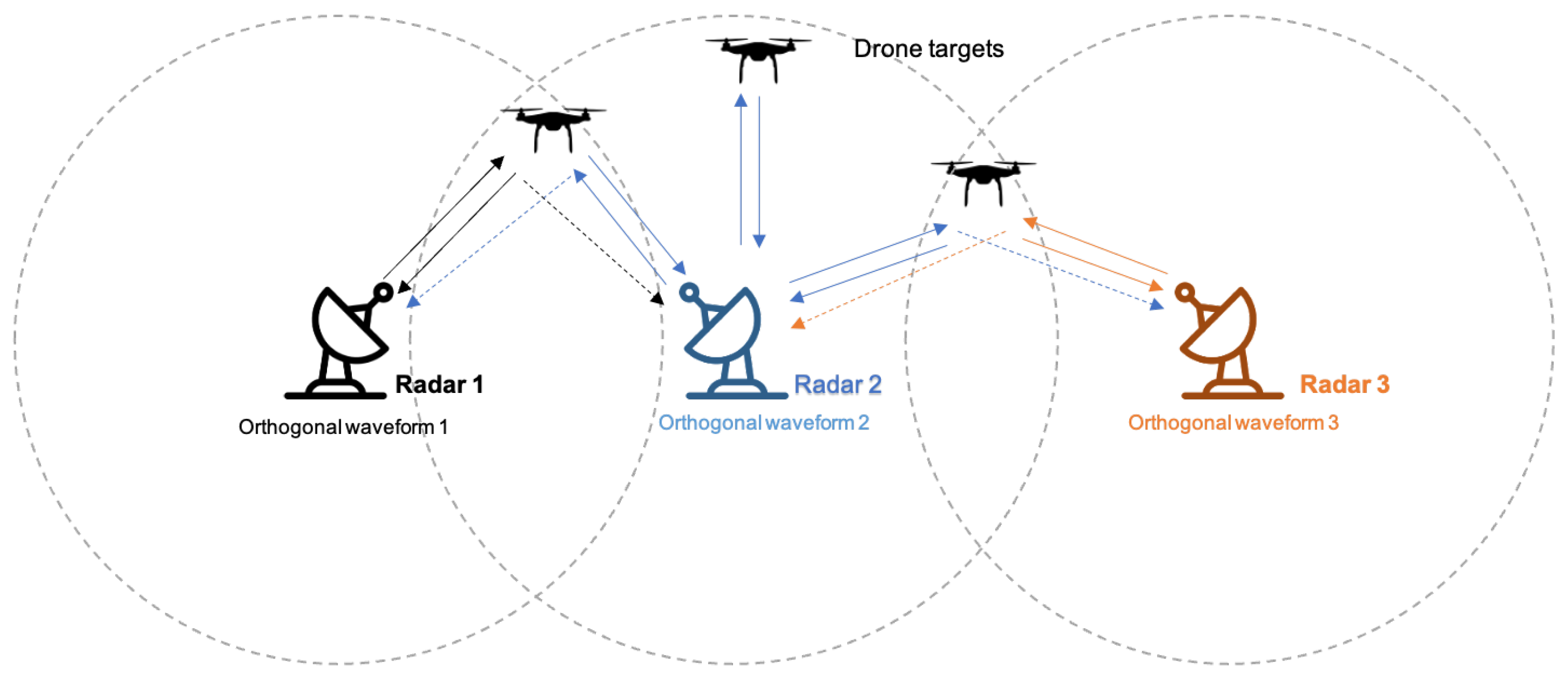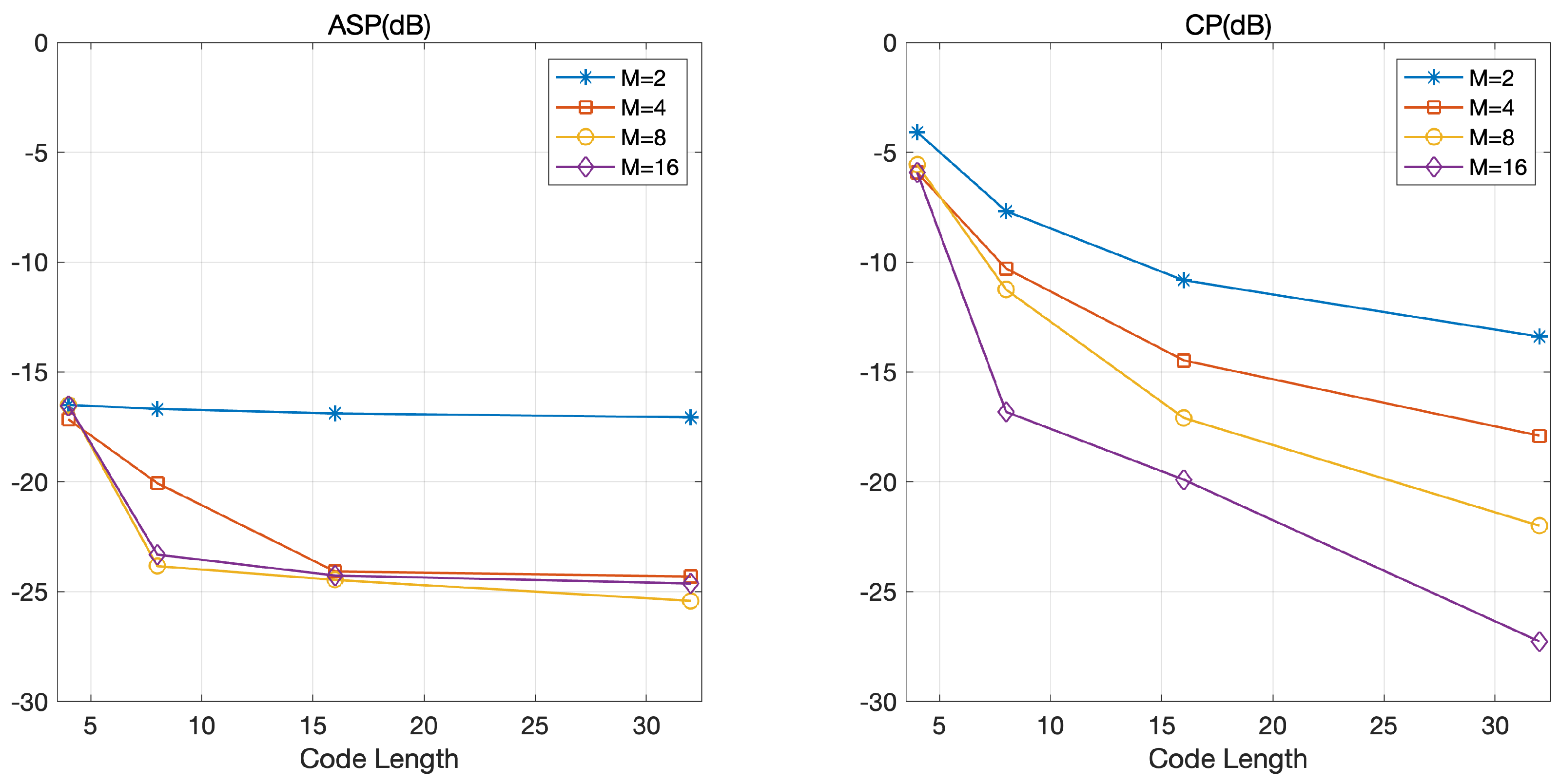Design of Optimized Coded LFM Waveform for Spectrum Shared Radar System
Abstract
:1. Introduction
- We propose a scheme for designing a set of optimized coded LFM waveforms to improve the orthogonality of previous proposals;
- The set of optimized coded LFM waveforms provides optimized orthogonality while inheriting various advantages of LFM;
- We propose an optimization framework for deriving the proposed optimal coded LFM waveforms;
- We conduct an in-depth study of the proposed optimal coded LFM waveforms through computer simulations and show that the proposed coded LFM waveforms outperform the orthogonal waveforms in previous proposals.
2. Related Works
3. Proposed Scheme
3.1. LFM Waveform
3.2. Polyphase Code Set
3.3. Coded LFM Waveform
3.4. Optimization Framework
- Generate an LFM waveform set, ;
- Generate a random polyphase code set ;
- Generate a set of coded LFM waveforms, ;
- Calculate the objective function, . Then, is adopted as a candidate of the optimized coded LFM waveform. If is smaller than , and are replaced with the current and . Otherwise, we do not change and (any global optimization algorithm (e.g., brute force, simulated annealing, the genetic algorithm, Bayesian optimization, etc.) can be used in this step to find the optimal state. In this paper, we employ simulated annealing (SA), which was also adopted by [4]. In simulated annealing, the transition, which corresponds to the update of the phase matrices and in our context, is determined by an acceptable probability function that depends on the scores of the two states and a global time-varying parameter T called temperature. If a random value p, where is a uniform distribution between 0 and 1, is less then , then the transition is accepted for the current state, , as a candidate of the optimized coded LFM waveform, . This probability prevents the algorithm from becoming stuck at a local minimum that is worse than the global minimum. Please refer to [4] for detailed operation);
- In the phase perturbation process, a randomly selected element in is replaced with a different admissible phase, which is defined in Equation (8);
- Repeat steps 3 to 5 until the stop condition is satisfied (we use the stop conditions adopted by [4]. If the phase perturbation is not accepted during three consecutive temperature reductions in the simulated annealing algorithm, then the optimization process is stopped).
4. Performance Evaluation
4.1. Impact of the Number of Radars
4.2. Impact of Code Length
4.3. Impact of the Number of Distinct Phases
4.4. Impact of the Weighting Factor
5. Discussion
6. Conclusions
Author Contributions
Funding
Conflicts of Interest
Abbreviations
| ASP | Autocorrelation Sidelobe Peak |
| CP | Cross-correlation Peak |
| DoF | Degree of Freedom |
| LFM | Linear Frequency Modulation |
| SSCL | Spread Spectrum Coded LFM |
| SSRS | Spectrum Shared Radar System |
References
- Deng, H. Orthogonal netted radar systems. IEEE Aerosp. Electron. Syst. Mag. 2012, 27, 28–35. [Google Scholar] [CrossRef] [Green Version]
- Geng, Z. Evolution of netted radar systems. IEEE Access 2020, 8, 124961–124977. [Google Scholar] [CrossRef]
- Lim, J.H.; Lim, D.W.; Cheong, B.L.; Song, M.S. Spectrum sharing in weather radar networked system: Design and experimentation. IEEE Sens. J. 2018, 19, 1720–1729. [Google Scholar] [CrossRef]
- Deng, H. Polyphase code design for orthogonal netted radar systems. IEEE Trans. Signal Process. 2004, 52, 3126–3135. [Google Scholar] [CrossRef]
- Majumder, U.; Bell, M.R.; Rangaswamy, M. Design and analysis of radar waveforms achieving transmit and receive orthogonality. IEEE Trans. Aerosp. Electron. Syst. 2016, 52, 1056–1066. [Google Scholar] [CrossRef]
- Ramarakula, M.; Ramana, V. Optimization of Polyphase Orthogonal sequences for MIMO Radar Using Genetic Algorithm with Hamming Scan. In Proceedings of the 2019 IEEE International Conference on Advanced Networks and Telecommunications Systems (ANTS), Goa, India, 16–19 December 2019; pp. 1–5. [Google Scholar]
- Bingnan, P.; Pei, T.; Zhang, H. Orthogonal Waveform Design of MIMO Radar Based on Niche Genetic Algorithm. In Proceedings of the 2020 IEEE International Conference on Signal Processing, Communications and Computing (ICSPCC), Macau, China, 21–24 August 2020; pp. 1–6. [Google Scholar]
- Tang, B.; Tuck, J.; Stoica, P. Polyphase Waveform Design for MIMO Radar Space Time Adaptive Processing. IEEE Trans. Signal Process. 2020, 68, 2143–2154. [Google Scholar] [CrossRef]
- Welstead, S. Characterization of diversity approaches for LFM stretch-processed waveforms. In Proceedings of the 2007 International Waveform Diversity and Design Conference, Pisa, Italy, 4–8 June 2007; pp. 418–422. [Google Scholar]
- Lulu, A.; Mobasseri, B.G. Chirp diversity waveform design and detection by stretch processing. In Proceedings of the 2016 IEEE Radar Conference (RadarConf), Philadelphia, PA, USA, 2–6 May 2016; pp. 1–6. [Google Scholar]
- Wang, W.Q. Large time-bandwidth product MIMO radar waveform design based on chirp rate diversity. IEEE Sens. J. 2014, 15, 1027–1034. [Google Scholar] [CrossRef]
- Qazi, F.A.; Fam, A.T. Good code sets based on Piecewise Linear FM. In Proceedings of the 2012 IEEE Radar Conference, Atlanta, GA, USA, 7–11 May 2012; pp. 0522–0527. [Google Scholar]
- Qazi, F.A.; Fam, A.T. Doppler tolerant and detection capable polyphase code sets. IEEE Trans. Aerosp. Electron. Syst. 2015, 51, 1123–1135. [Google Scholar] [CrossRef]
- Li, H.; Zhao, Y.; Cheng, Z.; Feng, D. OFDM chirp waveform diversity design with correlation interference suppression for MIMO radar. IEEE Geosci. Remote Sens. Lett. 2017, 14, 1032–1036. [Google Scholar] [CrossRef]
- Wanbing, G.; Zeng, X. Optimal Waveform Design Using Frequency-Modulated Pulse Trains for Active Sonar. Sensors 2019, 19, 4262. [Google Scholar] [CrossRef] [Green Version]
- Chang, G.; Liu, A.; Yu, C.; Ji, Y.; Wang, Y.; Zhang, J. Orthogonal Waveform with Multiple Diversities for MIMO Radar. IEEE Sens. J. 2018, 18, 4462–4476. [Google Scholar] [CrossRef]
- Wei, Y.; Mao, Z. Novel Range-Doppler Processing and Waveform Design Method for Extending Unambiguous Doppler. In Proceedings of the 2018 International Conference on Radar (RADAR), Brisbane, Australia, 27–30 August 2018; pp. 1–5. [Google Scholar] [CrossRef]
- MATLAB. Version 9.9.0.1592791 (R2020b); The MathWorks Inc.: Natick, MA, USA, 2020. [Google Scholar]
- Kim, B.K.; Park, J.; Park, S.J.; Kim, T.W.; Jung, D.H.; Kim, D.H.; Kim, T.; Park, S.O. Drone Detection with Chirp-Pulse Radar Based on Target Fluctuation Models. ETRI J. 2018, 40, 188–196. [Google Scholar] [CrossRef]
- Mahafza, B.R. Radar Systems and Design Using MATLAB, 3rd ed.; CRC Press: Boca Raton, FL, USA, 2013. [Google Scholar]







| Symbol | Description |
|---|---|
| L | The number of radars or waveforms |
| M | The number of distinct phases |
| N | Code length |
| Weighting factor | |
| Pulse width of an LFM waveform | |
| Chip time of a code sequence | |
| A set of LFM waveforms | |
| A set of polyphase code sequences | |
| A set of optimized polyphase code sequences | |
| A set of coded LFM waveforms | |
| A phase element in | |
| Autocorrelation sidelobe peak | |
| Main lobe width | |
| Cross-correlation peak | |
| Autocorrelation of the ith waveform | |
| Cross-correlation between ith and jth waveforms | |
| The objective function that minimizes and |
| Parameter | Default Value |
|---|---|
| , pulse width | 1 s |
| B, chirp bandwidth | 16 MHz |
| L, the number of radars | 4 |
| M, the number of phases | 2 |
| N, code length | 32 |
| , weighting factor | 0.5 |
Publisher’s Note: MDPI stays neutral with regard to jurisdictional claims in published maps and institutional affiliations. |
© 2021 by the authors. Licensee MDPI, Basel, Switzerland. This article is an open access article distributed under the terms and conditions of the Creative Commons Attribution (CC BY) license (https://creativecommons.org/licenses/by/4.0/).
Share and Cite
Kim, D.-H.; Kim, H.-J.; Lim, J.-H. Design of Optimized Coded LFM Waveform for Spectrum Shared Radar System. Sensors 2021, 21, 5796. https://doi.org/10.3390/s21175796
Kim D-H, Kim H-J, Lim J-H. Design of Optimized Coded LFM Waveform for Spectrum Shared Radar System. Sensors. 2021; 21(17):5796. https://doi.org/10.3390/s21175796
Chicago/Turabian StyleKim, Dong-Hoon, Hyung-Jung Kim, and Jae-Han Lim. 2021. "Design of Optimized Coded LFM Waveform for Spectrum Shared Radar System" Sensors 21, no. 17: 5796. https://doi.org/10.3390/s21175796
APA StyleKim, D.-H., Kim, H.-J., & Lim, J.-H. (2021). Design of Optimized Coded LFM Waveform for Spectrum Shared Radar System. Sensors, 21(17), 5796. https://doi.org/10.3390/s21175796







